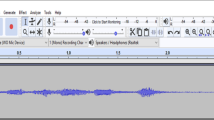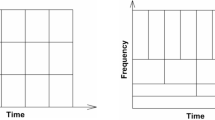Abstract
In this work we perform automatic recognition of continuous speech signal spoken in Gujarati language using machine learning (ML) technique. For this purpose, from continuous speech signal of sentence we first extract words using short term auto-correlation (STAC) method. Since the signals for each word are large in size, the dimension reduction is done using feature extraction algorithm: mel-frequency discrete wavelet coefficient (MFDWC). Then these features are trained using ML algorithm for recognition of speech.
Access this chapter
Tax calculation will be finalised at checkout
Purchases are for personal use only
Similar content being viewed by others
References
Rabiner, L.R., Juang, B.-H., Yegnanarayana, B.: Fundamentals of speech recognition. Pearson Education (2010)
Census of India 2011: http://censusindia.gov.in/
Juang, B.H., Rabiner, L.R.: Automatic speech recognition—a brief history of the technology. 1–24 (2005)
Davis, S.B., Mermelstein, P.: Comparison of parametric representations for monosyllabic word recognition in continuously spoken sentences. IEEE Trans. Acoust. 28, 357–366 (1980). https://doi.org/10.1109/TASSP.1980.1163420
Dua, M., Aggarwal, R.K., Biswas, M.: Discriminatively trained continuous Hindi speech recognition system using interpolated recurrent neural network language modeling. Neural Comput. Appl. 31, 6747–6755 (2019). https://doi.org/10.1007/s00521-018-3499-9
China Bhanja, C., Laskar, M.A., Laskar, R.H., Bandyopadhyay, S.: Deep neural network based two-stage Indian language identification system using glottal closure instants as anchor points. J. King Saud Univ. Comput. Inf. Sci. (2019). https://doi.org/10.1016/j.jksuci.2019.07.001
Goel, S., Pangasa, R., Dawn, S., Arora, A.: Audio acoustic features based tagging and comparative analysis of its classifications. In: 2018 11th International Conference Contemporary Computing IC3 2018, pp. 1–5 (2018). https://doi.org/10.1109/IC3.2018.8530512
Tufekci, Z., Gowdy, J.N.: Feature extraction using discrete wavelet transform for speech recognition. In: Conference Proceedings—IEEE SOUTHEASTCON. pp. 116–123 (2000)
Pandit, P., Bhatt, S.: Automatic speech recognition of Gujarati digits using dynamic time warping. Int. J. Eng. Innov. Technol. 3, 69–73 (2014)
Pandit, P., Bhatt, S., Makwana, P.: Automatic speech recognition of Gujarati digits using artificial neural network. In: Proceedings of 19th Annual Cum 4th International Conference of GAMS On Advances in Mathematical Modelling to Real World Problems. pp. 141–146. Excellent Publishers (2014)
Pandit, P., Bhatt, S.: Automatic speech recognition of Gujarati digits using radial basis function network. In: International Conference on Futuristic Trends in Engineering, Science, Pharmacy and Management. pp. 216–226. A D Publication (2016)
Pandit, P., Bhatt, S.: Automatic speech recognition of Gujarati digits using wavelet coefficients. J. Maharaja Sayajirao Univ. Baroda. 52, 101–110 (2017)
Tufekci, Z., Gowdy, J.N., Gurbuz, S., Patterson, E.: Applied mel-frequency discrete wavelet coefficients and parallel model compensation for noise-robust speech recognition. Speech Commun. 48, 1294–1307 (2006). https://doi.org/10.1016/j.specom.2006.06.006
Rumelhart, D.E., Hinton, G.E., Williams, R.J.: Learning representations by back-propagating errors. Nature 323, 533–536 (1986). https://doi.org/10.1038/323533a0
Kingma, D.P., Ba, J.L.: Adam: A method for stochastic optimization. In: International Conference on Learning Representations. pp. 1–15 (2015)
Maas, A., Hannun, A., Ng, A.: Rectifier nonlinearities improve neural network acoustic models. In: ICML Workshop on Deep Learning for Audio, Speech and Language Processing (2013)
Author information
Authors and Affiliations
Corresponding author
Editor information
Editors and Affiliations
Rights and permissions
Copyright information
© 2021 The Editor(s) (if applicable) and The Author(s), under exclusive license to Springer Nature Singapore Pte Ltd.
About this paper
Cite this paper
Pandit, P., Makwana, P., Bhatt, S. (2021). Automatic Speech Recognition of Continuous Speech Signal of Gujarati Language Using Machine Learning. In: Sahni, M., Merigó, J.M., Jha, B.K., Verma, R. (eds) Mathematical Modeling, Computational Intelligence Techniques and Renewable Energy. Advances in Intelligent Systems and Computing, vol 1287. Springer, Singapore. https://doi.org/10.1007/978-981-15-9953-8_13
Download citation
DOI: https://doi.org/10.1007/978-981-15-9953-8_13
Published:
Publisher Name: Springer, Singapore
Print ISBN: 978-981-15-9952-1
Online ISBN: 978-981-15-9953-8
eBook Packages: Intelligent Technologies and RoboticsIntelligent Technologies and Robotics (R0)




